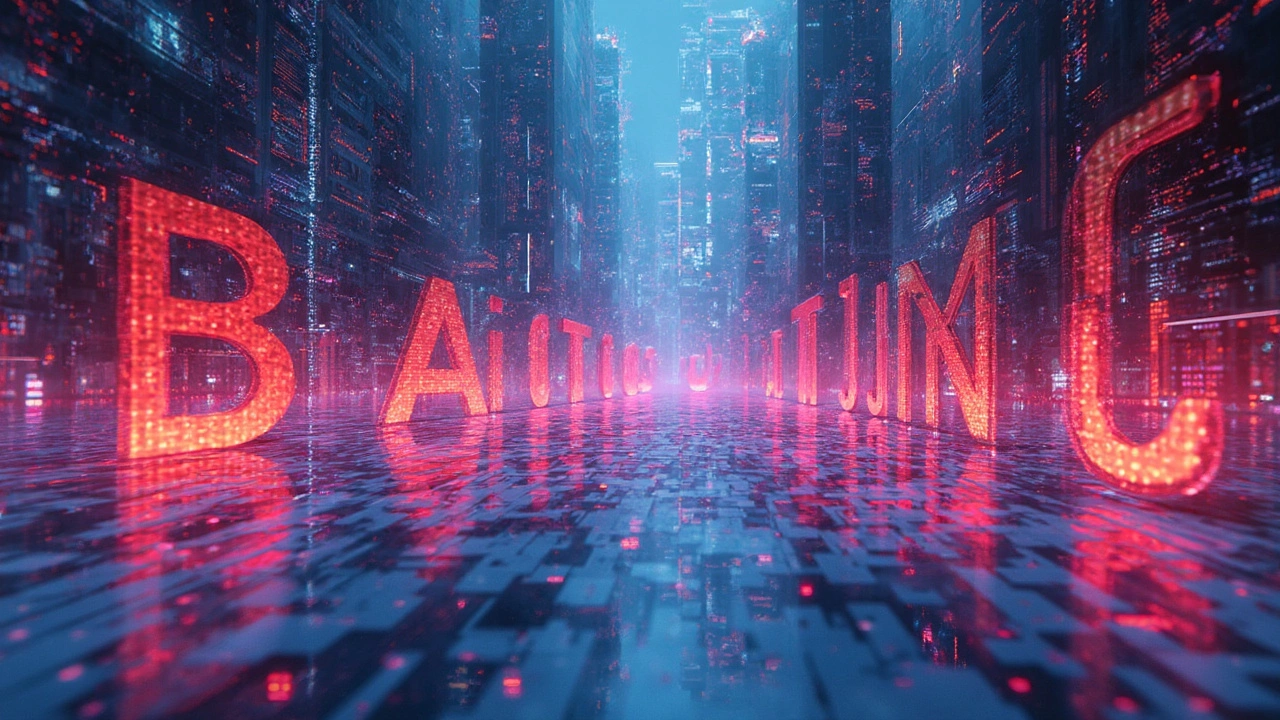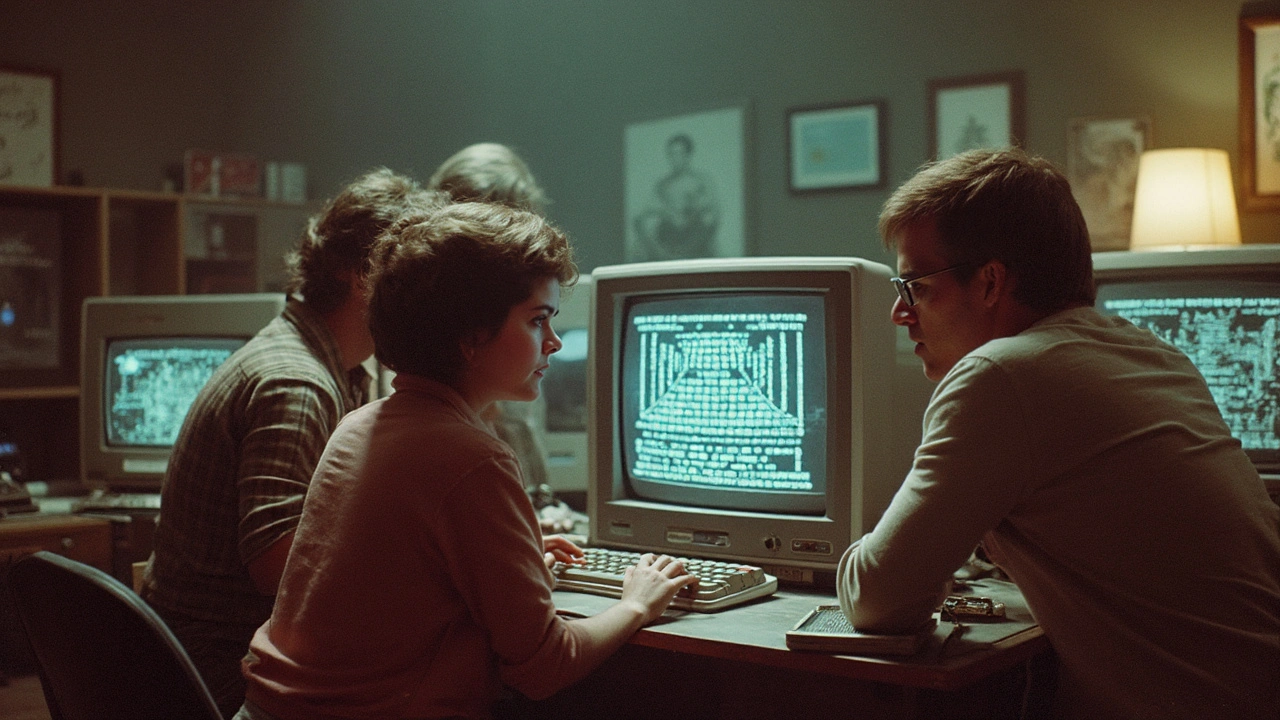If you've ever squinted at an image trying to find a hidden pattern, you're going to love ASCII stereograms. These nifty little tricks of text art let you see three-dimensional shapes by simply tweaking how characters line up in an image. Imagine turning a string of letters into a mind-bending illusion that seems to leap off the screen. Sounds like something out of a sci-fi movie, right?
But it's not just magic; it's all about how our eyes work. By aligning patterns in a specific way, these stereograms mess with your depth perception. The trick is in learning to converge or diverge your eyes to 'see' the 3D shapes. Don't worry if it takes a minute to get the hang of it, though. Once you crack the code, the effect is super rewarding.
- What are ASCII Stereograms?
- How They Create the Illusion
- Historical Roots and Innovators
- Modern Techniques and Applications
What are ASCII Stereograms?
ASCII stereograms are like magic tricks for your eyes, using plain text to create mesmerizing 3D illusions. These artworks rely on a clever mix of optical illusions and pattern alignment. By shifting characters horizontally, they trick your brain into seeing depth where there appears to be none.
The basic idea is pretty straightforward. You have a repeated pattern, and you adjust its alignment just enough, so when your eyes look at it in a certain way, they pick up a hidden image or shape. It's like those childhood toys where you crossed your eyes to reveal a hidden dinosaur or spaceship hiding in a mishmash of shapes. But here, it's done purely with text symbols instead of colors or graphics.
This technique taps into how we naturally perceive depth through what's called 'binocular disparity'—basically, how our two eyes view things slightly differently to judge distance. ASCII stereograms play with this concept by making your eyes do a little dance, converging them to reveal the secret image. It's artsy and scientific at the same time, a nice blend of creativity and optical mind games.
ASCII art has been around for quite a while, and its simplistic style makes it very adaptable to this kind of trickery. What sets these stereograms apart is how they mix in the illusion of 3D, taking something flat and turning it into something with depth to blow your mind.
They're not just fun puzzles; ASCII stereograms also have an artistic value. Artists and enthusiasts across the globe have embraced them as a unique medium to explore creativity while inviting you to see something with fresh eyes. It’s a reminder that even the simplest of tools can create intricate and fascinating experiences. All you really need are a few lines of code and an adventurous spirit to dive into the world of text-based illusions!
How They Create the Illusion
Okay, so let's get into how these ASCII stereograms work their magic. At the core, they're all about messing with your visual perception using repeating character patterns. The key here is binocular disparity, which is just a fancy term for the way each of your eyes sees slightly different views of the world.
When you look at these text patterns and align your eyes just right, it tricks your brain into thinking there's depth, even though you're staring at something flat. Essentially, the patterns are shifted horizontally. Imagine rows of letters or symbols like O and + repeating just enough to play with how your eyes perceive distance. It's like making your eyes do a little dance to reveal the 3D image.
Getting this effect isn't about complex tools or technology. Unlike traditional stereograms that might need a viewing device, ASCII stereograms only require the viewer to adjust focus. The challenge and fun are in training your eyes to merge these patterns into a coherent 3D design.
How cool is that, right? You don't need any expensive gadgets or special glasses. It's just your own two eyes doing all the work, which means anyone with the right guidance can see these nifty illusions.
If you're trying this at home, here are some tips to help you see the hidden images more easily:
- Relax your eyes: Try not to strain. Let your eyes go slightly out of focus and see if the patterns start to come together.
- Use a point of focus: Sometimes focusing on aligning specific points in the pattern—like making two
Os form a third in the middle—can help your brain catch on. - Be patient: It may take a few tries before the image pops out, so hang in there and enjoy the process.
These illusions are a fascinating blend of art and science, showing us just how clever our brains can be when it comes to 'seeing' in new ways.

Historical Roots and Innovators
Diving into the world of ASCII stereograms reveals a fascinating history. This art form has roots stretching back to the early days of the internet, particularly through the vibrant communities on USENET newsgroups. Around the late 1980s and early 1990s, these online spaces buzzed with creative energy where tech enthusiasts shared their experiments and discoveries.
Key figures in the development of stereograms included David B. Thomas, Jonathan Bowen, and Marty Hewes. These pioneers didn't just dabble in text art; they explored how simple character patterns could be nudged and tweaked to create mind-bending, three-dimensional illusions. USENET became a hub for such innovations, with the group *alt.3d* hosting lively discussions and a slew of eye-popping artwork.
One of their cool discoveries was how sliding characters horizontally could create depth effects, simulating binocular disparity—the difference in image location of an object seen by the left and right eyes. This technique wowed not just artists but also educators looking for interesting ways to explain visual perception.
These early ASCII stereograms weren't just fun to look at; they were a gateway into a deeper understanding of how we see the world. And it's pretty cool that despite the rise of high-def everything, these text-based 3D experiments continue to intrigue both beginners and seasoned artists alike.
Modern Techniques and Applications
So what’s happening with ASCII stereograms today? Well, these funky text-based illusions have gotten a tech upgrade. The basic idea of creating depth using repeated text patterns remains, but modern approaches add a layer of high-tech wizardry to the mix. Remember how we talked about shifting characters to create 3D shapes? Nowadays, developers use depth mapping and computer vision to automate these shifts, allowing for more complex and dynamic animations.
Consider this: combining ASCII art with software can make images change their depth perception on the fly. By using depth maps, computers can programmatically adjust the horizontal shift in text patterns, almost like giving ASCII art a little brain of its own. This adds a whole new dimension (literally!) to how we think about creating illusions.
But it's not all techy mumbo jumbo. These modern techniques make 3D illusions using text accessible to everyone, without needing any special glasses or equipment. This magic of turning simple text into perceived depth is also playing a role in education. Teachers are using these illusions to help explain complex concepts in physics and optics, making learning a bit more interactive and fun.
On the other hand, artists are finding new ways to integrate these ideas into digital art projects. The blend of retro ASCII style with the sleekness of today’s technology results in art pieces that are both nostalgic and innovative. For developers and artists, these optical illusions offer a way to explore digital creativity and human perception at the same time.


Sheila Alston
July 18, 2025 AT 01:26Wow, I had no idea ASCII art could be so cutting edge with 3D illusions involved! It’s honestly so refreshing to see something that combines both creativity and science in such an elegant way.
I'm curious though, does anyone know if this kind of ASCII stereography has practical applications beyond just being cool or educational? I mean, could it be used in data visualization or maybe even modern digital design?
Also, I love how you mentioned the early USENET collaborations. It reminds me how sometimes the best things come from these early, community-driven projects, and not just corporate tech.
Has anyone tried creating one of these stereograms themselves? I'd imagine aligning characters perfectly to trick the eye must be quite a challenge!
sampa Karjee
July 18, 2025 AT 23:38Honestly, the obsession over ASCII stereograms seems a bit overhyped to me. It’s just text arranged in a pattern to create an illusion, nothing revolutionary.
If you want true depth perception and immersive experiences, virtual reality and augmented reality have done far better jobs these days.
Don’t get me wrong, I appreciate the history behind these USENET contributions, but let's not pretend that putting some ASCII characters in a grid is some grand artistic breakthrough.
It’s more like a party trick than a serious method of communication or visualization. Technology has moved on, so I don’t see much merit in dwelling on these text illusions.
Patrick Sieber
July 19, 2025 AT 16:18I think both points here have merit. On one hand, ASCII stereograms do feel quite retro, but on the other, their unique charm is in how accessible and low-tech they are.
There’s something fascinating about creating a 3D illusion out of plain text that anyone can view on any device, no special tech needed.
And their educational value shouldn’t be underestimated: they let people play with perception and understand visual depth in a very basic, approachable way.
It’s a niche art for sure, but one worth preserving and exploring further, especially with the newer algorithms and technologies mentioned.
Has anyone here experimented with creating these using modern code or software?
Kieran Danagher
July 20, 2025 AT 08:58ASCII stereograms? Oh great, because nothing says 'cutting edge' like rehashing flat, pixelated text to simulate 3D perception 🙄.
It’s amusing how we’ve had VR and AR pushing real immersion, yet people still find joy in these text-based optical illusions.
But hey, each to their own. If you want to feel like you’re staring into the abyss of 90s internet nostalgia while your eyeballs try to figure out what’s popping out, go ahead.
Honestly, if they developed it enough to be a teaching tool or an insightful visual tech, maybe I’d be impressed, but for now it just looks like ascii magic tricks.
OONAGH Ffrench
July 22, 2025 AT 10:58Well, from a philosophical viewpoint, ASCII stereograms exemplify how simplicity can create complexity—a motif deeply embedded in human perception.
A two-dimensional plane, merely text characters, project depth where none exists. It evokes questions about the nature of reality and illusion.
Despite their apparent simplicity and origin in early internet culture, they are profound demonstrations of how minimal elements can orchestrate diverse cognitive responses.
Rather than dismissing them as archaic, it’s more fruitful to contemplate what underlying mechanisms of the mind they expose.
poonam upadhyay
July 23, 2025 AT 17:31Seriously though, how is anyone even impressed by ASCII stereograms? It’s just blocks of letters and characters slapped together—no real skill required, just some dumb luck in aligning shit so your eyes get confused.
And calling it ’art and science’ is a joke when modern imaging techniques can create actual 3D models that look far more convincing and useful.
People need to stop romanticizing these glorified eye strain machines. It’s all surface level nonsense masquerading as deep intellectual fun.
Who’s actually benefited from this? Enlighten me, because I’m genuinely dumbfounded by the hype.
Shivam Mogha
July 25, 2025 AT 19:31To put it simply, ASCII stereograms are a neat blend of visual and cognitive trickery.
They offer a straightforward way to experience depth perception without specialized hardware.
Though niche, their simplicity can inspire creativity and discussions on perception mechanisms.
Not every innovative idea has to be flashy or complex to have value.
mani kandan
July 28, 2025 AT 22:31I find ASCII stereograms a fascinating intersection of old-school tech and modern visual science.
They bridge eras, showing how text-based mediums can evolve with technology to offer engaging, educational visuals.
Their ability to demonstrate how human vision interprets patterns is quite remarkable and shows that even simple things can hold depth—literally and figuratively.
Anyone else here tried creating their own? Would love to hear about your process and insights.
Rahul Borole
August 3, 2025 AT 06:18As someone involved in visual computing, I recognize the educational value of ASCII stereograms.
They serve as excellent examples of perceptual illusions and can be useful for teaching basic concepts of depth and pattern recognition.
While not cutting-edge tech themselves, their integration with modern methods opens possibilities for creative pedagogy.
I encourage more research and application of such tools in educational technology.
Good post highlighting an often overlooked art form.
Sheetal Srivastava
August 14, 2025 AT 14:31I'm honestly irked by how some folks romanticize ASCII stereograms as if they’re some sublime artistic revelation. They’re little more than repetitive character arrays crafted to baffle the eye—not exactly high art.
The post’s poetic framing reeks of needless glorification of lowbrow tech. Let’s be real: these illusions are trivially generated and easily surpassed by current visual media.
Frankly, it’s a cheap gimmick worn thin by nostalgia seekers failing to appreciate the sophistication of true visual design.
Anyone else think this kind of tech jargon-filled fluff distracts from genuine advances in optical science?